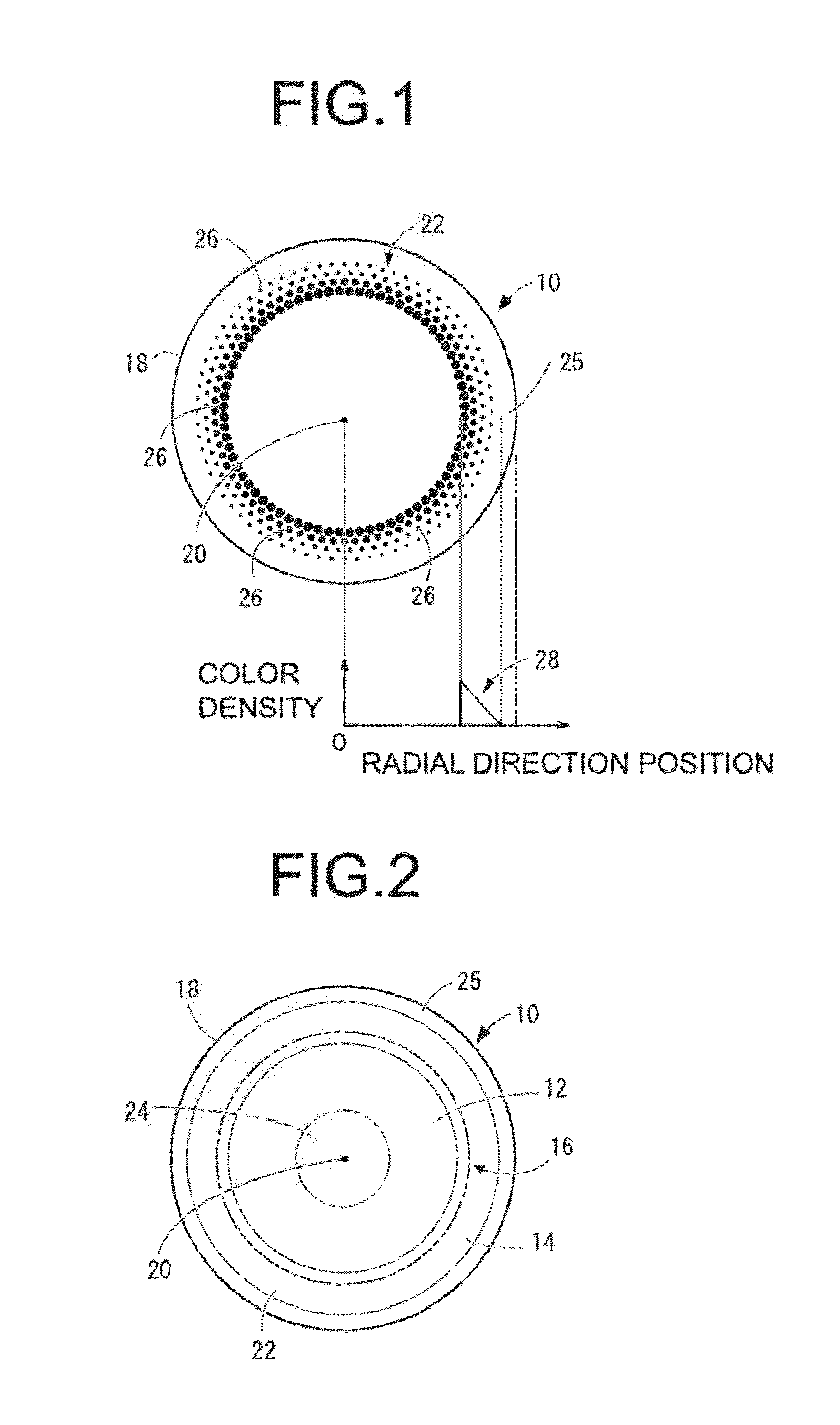Colored contact lens
a contact lens and color technology, applied in the field of colored contact lenses, can solve problems such as difficult to say, and achieve the effect of bringing out beauty
- Summary
- Abstract
- Description
- Claims
- Application Information
AI Technical Summary
Benefits of technology
Problems solved by technology
Method used
Image
Examples
example 1
[0086]As the pigment composition, 1.0 parts by mass of polymerizable pigment 1,4-bis:((ethyl phenyl)amino)-anthraquinane which exhibits a green color, 2,0 parts by mass of 2-hydroxy2-methyl-1-phenylpropane-1-one as the radical polymerization initiator, as well as 100 parts: by mass of 1-methyl-2-pyrrolidillone as a solvent were mixed to prepare:a:pigment composition.
[0087]Next, using:a piezo type inkjet device, on the :front surface side of the 2 Week Premia (registered: trademark) available on the market and made: by Menicon Co., Ltd: which is a soft contact lens consisting of a silicone hydrogel, by respectively printing a large number colored dots 26 independently for which the diameter is in a range from φ 10 min to φ 13.0 mm around the lens geometric center axis, a ring shaped colored band 22 was provided. The same as with the fourth embodiment shown in FIG. 5, of the colored band 22, a fixed density area 31 was formed in the inner circumference area of φ 10 mm to φ 11.5 mm, an...
example 2
[0089]The colored band 22 is formed with a diameter in the range of a φ 10.5 mm to φ 12.0 min around the lens geometric center axis 20, and the inner circumference area of φ 10.5 mm to φ 11.0 mm was made to be a fixed density area, and also in the radial direction dimension area of φ 11.0 mm to φ 12.0 mm, the concentration of the colored dots 26 was made to be different in the radial direction so as to form a pattern having an area for which the color density gradually decreases from the inner circumference side toward the outer circumference side. The remainder was done the same way as with example 1 to obtain the colored contact lens.
example 3
[0090]As the pigment composition, instead of the 1.0 parts by mass of polymerizable pigment 1,4-bis((ethenyl phenyl)amino)-anthraquinone of example 1, used was 1.0 parts by mass of a known polymerizable azo type dye noted in paragraph [0041] of International Patent Publication No. WO 2009 / 044853 that exhibits a dark blue color. The remainder was done the same way as with example 1 to obtain the colored contact lens.
TABLE 11) Evaluation of Impression by the Wearer Him / HerselfChoiceQuestionb) I don'tc) NotContentLensna) I agreeagreesureA) The impres-Example 15401sion changed Example 25401comparedExample 33300to when notComparison5401wearing.ExampleChoiced) Thee) Theexamplecomparisongives aexamplemoregives aQuestionnaturalmore naturalf) NotContentLensnimpressionimpressionsureB) Regarding Example 15410the impression Example 25410whenExample 33111wearingChoiceh) Theg) Thecomparisonexampleexamplegives thegives thewhite partwhite partof the eye aof the eye aQuestion whiterwhiterf) NotConte...
PUM
| Property | Measurement | Unit |
|---|---|---|
| outer diameter | aaaaa | aaaaa |
| inner diameter | aaaaa | aaaaa |
| inner diameter | aaaaa | aaaaa |
Abstract
Description
Claims
Application Information
 Login to View More
Login to View More - R&D
- Intellectual Property
- Life Sciences
- Materials
- Tech Scout
- Unparalleled Data Quality
- Higher Quality Content
- 60% Fewer Hallucinations
Browse by: Latest US Patents, China's latest patents, Technical Efficacy Thesaurus, Application Domain, Technology Topic, Popular Technical Reports.
© 2025 PatSnap. All rights reserved.Legal|Privacy policy|Modern Slavery Act Transparency Statement|Sitemap|About US| Contact US: help@patsnap.com



